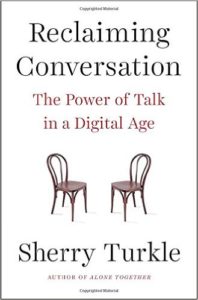 Is the explosion of digital technology a good thing for us as individuals and as societies?
Is the explosion of digital technology a good thing for us as individuals and as societies?
The knee jerk reaction has been to say, “Of course!” But there’s a real cost, and Sherry shares what we are losing and what we aren’t even aware we’re losing. Until we wrap our heads around how to use technology instead of letting it use us, we’re going to struggle with finding healthy ways to incorporate it into our lives. This is especially true for a generation of digital natives that has always known technology and is maturing into a key part of our society and workforce.
Big Thought
Even though there’s a plethora of new technological tools for communicating, real conversation is waning. While technology will be an on-going part of our lives, we have to find a way to balance its ability to connect us with its ability to isolate us. Social media, robotics, and ubiquitous cellphones are short-circuiting our attempts at creating self-identity, sharing empathy, and developing integrated communities.
Ideas, Implications, and Questions
- When looking at ways technology can help in the therapy world, Sherry writes,”Apps can give you a number; only people can provide a narrative. Technology can expose mechanism; people have to find meaning.” (pg 81) But it’s really easy these days to confuse mechanism for meaning. For this to shift, we have to see a cultural shift first which values meaning. In a day when we try to fix all of our problems with pharmaceuticals (because we think our mind is a mechanism that isn’t working), that will take some time.
- Sherry offers an idea about technology use by parents vs. children that just as easily applies to experienced vs. younger professionals: “Parents should not be looking for an equalizer, because all things are not equal. If parents fear their children’s technological expertise, it can lead parents to forget that they have a lifetime of experience to share-that their children don’t have.” (118) Just because digital natives are comfortable with technology, it doesn’t mean that they have the business knowledge to successfully communicate.
- I often struggle when trying to define the parts of interaction that are lost when you solely rely on technological communication tools. Sherry hits on one idea over and over, and I think she’s right: it’s empathy. Social media and texting are great for sharing information, but they don’t share empathy.
- I often share with audiences that the advances in technology aren’t going away. We’re never going to stop using social media, for example, even if the specific sites change. That doesn’t mean we have to blindly use all these tools. Sherry write, “…but laptops and smartphones are not things to remove. They are facts of life and part of our creative lives. The goal is to use them with greater intention.” (216)
- Multitasking doesn’t work. Let’s just accept that and find ways to focus on one task.
- I often hear of younger professionals caught in this cycle where they are so overloaded that they don’t want to have human interaction (which can be messy). Why have a conversation with a co-worker when you can send an email? But then they lose out on the social aspects of work which are personally satisfying and lead to better professional solutions as well. Sherry gives an example, “Hassoun craves control more than sociability…(She) sees emotional exposure as stress that she doesn’t have to subject herself to. Hassoun’s protocols for self-protection leave her with a lot of work problems that email can’t quite fix. And they leave her feeling lonely.” (pg 265)
- While it’s a good explication of the challenges that technology and social media are creating, I don’t see a lot of solutions in the book. Sherry keeps saying the way to solve for the lack of conversations is to have more conversations. It’s a bit of a tautology. I think that the next place to put attention is on how to be intentional when using these tools (especially when they are designed to try to make your use of them habitual and unthinking). Some next steps she does address:
- Champion conversation in the day-to-day.
- Encouraging conversation gives you permission to encourage solitude. Give yourself and others permission to think – sometimes alone – and provide time and space to do so.
- Address the anxiety of disconnection.
- Support the first steps toward solitude.
Should you read this book? Who should read this book?
While it’s a relatively lengthy book, it is full of fantastic anecdotes that illustrate the very real challenges that people are facing in families, schools, and workplaces. It’s worth reading (even if it’s just for your relevant area) if you are in:
- The social media function in a large organization and curious about how it can help, rather than hurt, your company culture.
- A school environment and want to know how to support digital natives who might understand cell phones but not human relationships.
- The middle of parenting a middle-schooler who is wrestling with how to create an identity and still have the “perfect” Facebook page.
